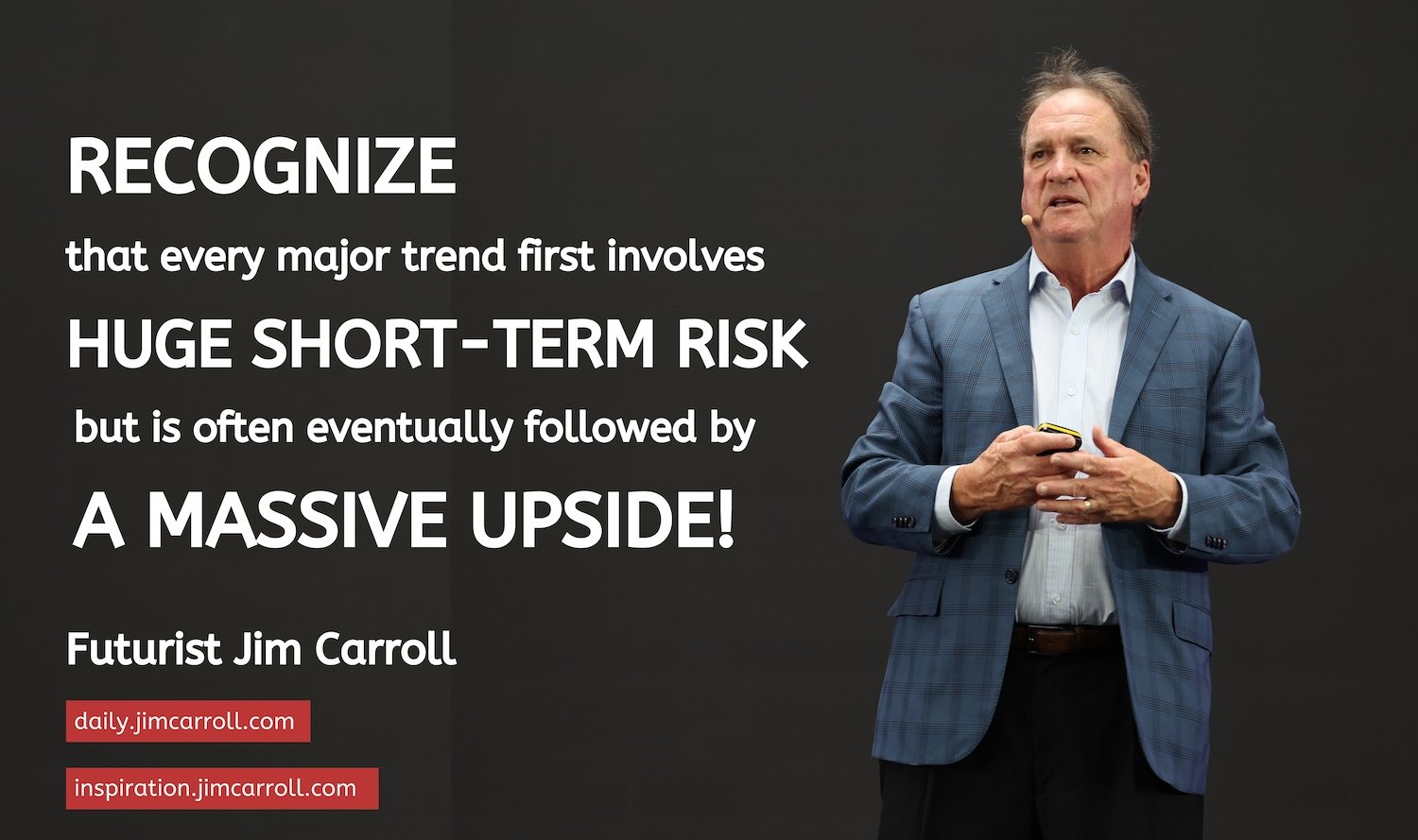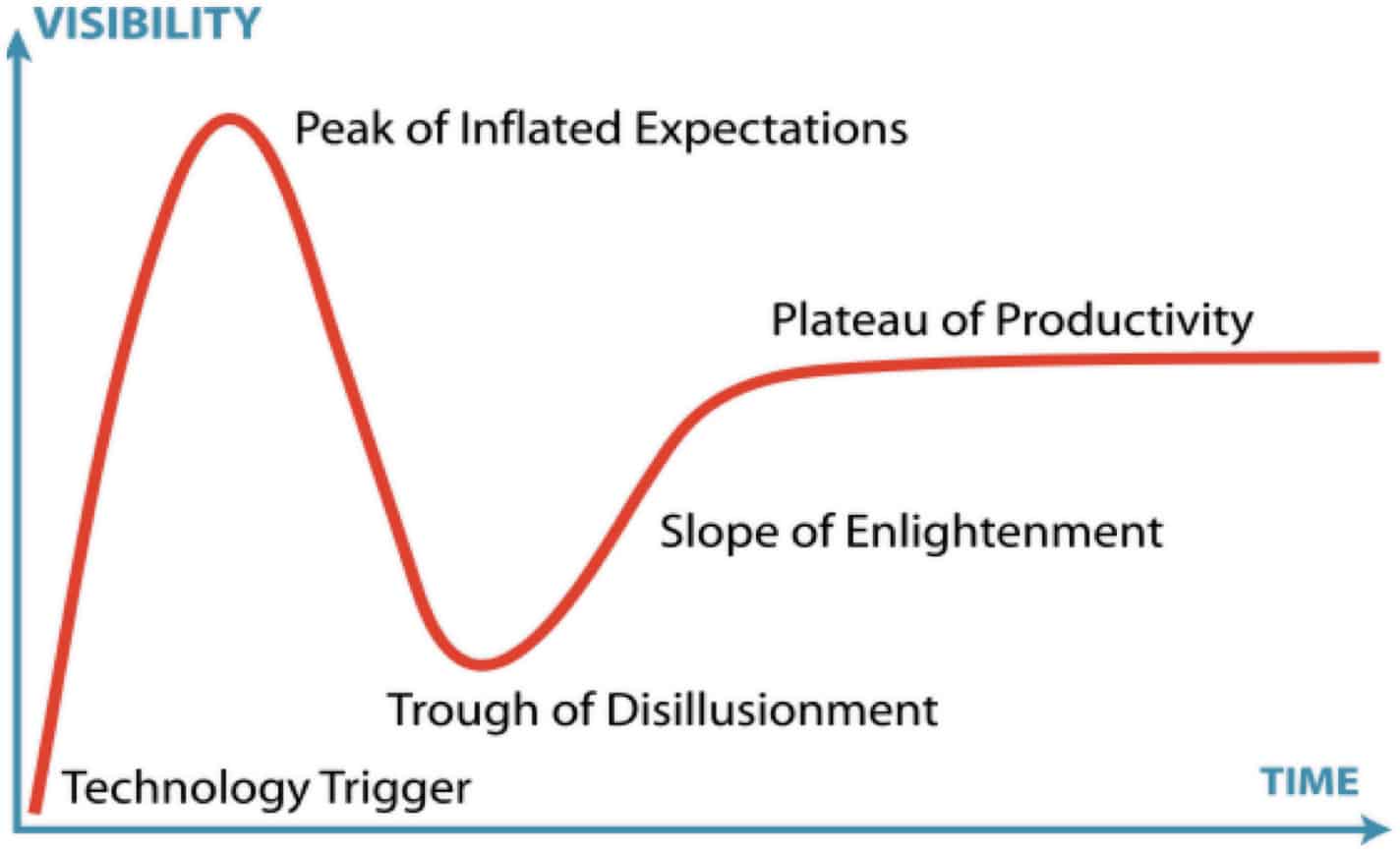“Recognize that every major trend first involves huge short-term risk but is often eventually followed by a massive upside!” – Futurist Jim Carroll

One of the most important things to realize about any future trend is that it can be pretty difficult to achieve any opportunity from it until it matures.
That means that in the short term, it can be pretty painful – but in the long pretty, significantly wonderful.
Take the idea of e-commerce. Back in the late 90s when the idea was first coming to the forefront, it was pretty clear that many of the early startups were doomed to fail. I wrote about this in my Globe & Mail column at the time, and was interviewed many times in print, radio and TV about the trend.) I wrote this particular column with a fair bit of snark. (You could change the topic of the article today to ‘artificial intelligence’ and it would still work.)

How to take your bite in Internet frenzy
29 April 1999, The Globe and MailRecently, I’ve been spending a lot of time trying to determine what makes the current round of Internet startups so successful, at least in terms of investor perception. After all, if a company can go from a market value of zero to several billion dollars in a matter of a year, it must be doing something right.
My theory is that if entrepreneurs can figure out the secret of these companies and emulate their activities, they’ll be set to succeed in the new economy.
So here’s my list of what makes for a great Internet strategy and how to be a successful electronic business. Keep in mind that I’m sharing the results of my research for the first time. It’s been kept under a tight lid, as I’m convinced the list is a valuable piece of information.
The first rule for success for an E-biz is: Don’t have a business plan. Throw out all of those antiquated suggestions that you should carefully think through your future. This is the Internet — make it up as you go along. If you don’t like what you are doing this week, change it next week. E-biz moves fast, and so should you.
Second, don’t plan on having any management. In the absence of old-fashioned notions such as strategic planning, it isn’t important that you actively manage your E-biz. These things run themselves. Management only gets in the way of success.
Third, don’t have a product, or at least one that people might be interested in buying. If you do make a mistake and actually have something to sell, make sure that you don’t have any real, sustainable competitive advantage.
It is crucial that rivals be able to walk in at a moment’s notice and steal away your market share — this reality will make you strong and give your company fortitude.
Fourth, and this is vital, don’t plan for revenue. Such a thing is out of place with an E-biz. Should you miss this all-important factor and manage to have money coming in, then take some time to ensure that your bottom line shows a massive loss so that you can keep up with your E-biz peers.
How can you do this? I’ll let you in on a secret — give stuff away at a loss, and make it up in volume.
Fifth, be prepared to spend gazillions of dollars on marketing and public relations. Quickly establish a buzz in the marketplace that you are a dot.com company and that you’ve got the magic Internet touch.
Make sure everyone is aware that you’ve met all of the criteria above, and you are bound to generate huge amounts of interest in the media and investment community.
Finally, use all of these factors to raise some venture capital. There are all kinds of decent, moral companies keen to help turn your dreams of E-biz into reality by lining you up with highly intelligent investors eager to provide you with seed capital.
Is this all tongue in cheek? Yes. Now wander over to Web site www.heyidiot.com and have a good chuckle.
My biggest fear is that many entrepreneurs are becoming easily dazzled by Internet hype and think real E-biz is easy. Or in other cases, small-business owners have become convinced that E-biz is simply the latest craze, soon to disappear. They discount its importance altogether.
If you fall into either camp, then it’s time for a reality check.
At the time, I was cautioning people against taking a career in a dot.com company, because the risk was pretty significant. I remember taking a LOT of abuse for this particular column, being accused of ‘crushing dreams,’ and ruining potential career decisions. It was an interesting time to be writing about the inevitable failure of a major trend!
Report on Business: Dot-com careers among riskiest
21 February 2000, The Globe and MailShould you quit your job to join a dot-com? It’s a question more and more people are asking themselves. It seems there is a massive exodus from the traditional business world to the universe of the dot-com.
Most recently, the business press has reported on the flood of professionals from leading U.S. law firms to the high-profile Silicon Valley Internet startups.
Certainly, the temptations spurring such moves are strong — particularly the stock options associated with dot-coms. These perks appear to be on an ever-increasing upward spiral, guaranteed to make you rich beyond your wildest dreams.
But it’s not just the draw of the money that is gaining attention. Stuck in a humdrum job in a company that doesn’t “get” the e-biz revolution, many people simply want to join the excitement of the dot-com universe, and become part of the work force that is out to change the world economy.
There’s a party going on, and the natural inclination for people is to want to take part.
Yet most people pondering such a move also realize there is undeniable risk with any Internet organization. Unproven business models, spotty revenues, and uncertain guarantees regarding long-term survival make a dot-com career one of the riskiest around.
While a number of high-profile winners are being featured in the media, there are an equal number of lowly foot soldiers labouring in the trenches, barely enjoying the fruits of the revolution.
If you want an idea of how bad things can get, take a look at the book Net Slaves: True Tales of Working the Web by Bill Lessard and Steve Baldwin.
The opportunity seems so exciting, yet the risk seems so high. What should you do?
First, take the leap of faith into the dot-com universe only if you can weather any possible storm. This means that you should have a secure financial background, the skills to bounce back into a “regular job,” and an attitude that it won’t be a crushing blow if you, or the company you join, fails.
Second, take the time to carefully research the organization that you join. There are a huge number of dot-coms out there, and some, quite simply, don’t deserve to be in business, and probably won’t be within a year.
Of particular note, be cautious in joining on-line retail ventures. I’m convinced that the long-term survival of many of these organizations is doubtful. The real opportunities are found in companies focusing on business-to-business commerce, Internet infrastructure, and e-commerce software development.
What’s more, the companies that concentrate on supporting serious e-commerce ventures are bound to be a big emerging market, as well. Look for opportunities in customer-support applications, business re-engineering firms, consulting organizations and other such support businesses.
Third, make sure that your leap into the dot-com world involves a career and a job that mixes technical and business skills. Don’t get yourself in a situation where you are just technically focused, since it is the business background that is so important.
It’s crucial that you don’t get pegged as a “techie,” since that might doom you to the type of career described in Net Slaves.
In addition, find out if the company you currently work for plans to establish a separate e-commerce division or company. I’m convinced that in the next little while, we will see the emergence of many dot-coms which have an umbilical cord link to a larger, established organization.
Many big companies have come to realize that they are simply unable to cope with the rapid rate of change and cultural uniqueness of the e-commerce/ Internet world. To move forward, they will establish separate divisions or even separate companies to take their e-commerce strategies forward. Joining one of these organizations might make more sense and be far less risky than a full-fledged jump to a dot-com.
Last but not least, be realistic, and don’t get in over your head. Something big is happening with the Internet and e-commerce; wonderful new careers beckon. But there are tremendous risks, big challenges, and an uncertain future with any organization, and so extreme caution has to be the watchword.
Months later, the dot.com sector saw a spectacular flameout – billions in market cap evaporated, companies disappeared, and careers of tohose in the business were destroyed.
Even so, I was also suggesting that in the long term, e-biz and e-commerce would be massively significant. Shopify, one of the leading e-commerce platforms, would not be established until 5 years later.
Digital survivors: Stick to your guns
26 March 2001, The Globe and Mail
The title for this column, Digital Survivor, struck me the other day as being particularly apt for these times.
My intent with this column has always been to help people understand how they can take advantage of particular technologies, understand the impact of technological change on their working lives, or think about how technology will change their business. Based on e-mail from readers, it seems we are succeeding at that task.
And yet, having read several anti-dot-com articles recently, the phrase “digital survivor” brings another theme to mind. There are a lot of people whose careers are dependent upon information technology, and who are now feeling rather battered and bruised by the shift in opinion over the dot-com collapse.
There is no doubt that there is a lot of anger out there. Many people have been burned by their dot-com investments, the market is in a funk, and technology stocks seem to be a guaranteed ticket to the poor house. As we watch the fortunes of many dot-com millionaires around us crash and burn, there is no doubt a palpable glee emanating from some corners.
As the Boston Herald recently commented in an article focusing on the dot-com collapse, “Do you delight in the financial misfortunes of others? Of course you do.”
And this line from U.S. columnist Dave Berry: “Nasdaq went deep into the toilet, which meant we heard a LOT fewer stories about 22-year-old dot-com twerps making $450-million for starting companies that never actually produced anything except press releases.”
But just as the excitement about the dot-com era went to an extreme, the hype is now swinging to the other extreme. Listen to some pundits, and it would seem that the era of the Internet, information technology, e-biz and any other matter involving a computer chip is over.
Which brings us to the “survivor” issue. There are several million people in Canada whose careers are directly related to information technology.
Like me, they’re getting a little tired of the dot-com bashing.
And yet in these times, to be a digital survivor, you must have a rather thick skin. Indeed, my skin has become so thick that I could be considered positively reptilian.
In 1982, I began suggesting that a tool called e-mail would change the way we worked, and that most of us would one day find it to be indispensable. At the time, remember, personal computers were barely in the workplace and people strongly advised me to get a life.
Of course today, the dot-com pundits are probably using e-mail to submit their columns.
Around 1987, I became immersed in the then-emerging concept of knowledge management. I became convinced, as did many, that there were extraordinary business benefits, if we could only electronically harness and capture the collective knowledge of our staff. Of course, my comments were often met by blank stares, and my business strategies were dismissed. Today? Knowledge management has become a billion-dollar business, and many organizations have been forever transformed.
There are many other pioneers out there who, over the last 20 years, have witnessed a technology in its early days, came to realize its potential, and helped to work its magic into the corporate sector. Sticking to their guns and beliefs, they all became digital survivors.
Yet being a digital survivor doesn’t just mean promoting certain information solutions ahead of your time. It also means being realistic about technology’s potential and its role when things go to the other extreme.
In the past two years, I’ve ridiculed the intensity of the dot-com phenomenon many times, suggesting that things were getting out of hand. I got a lot of angry flame-mail telling me I was ruining the party.
Today, I hold my head up high, knowing I didn’t succumb to the silliness, making me and many others across Canada, digital survivors.
It’s time we end the dot-com bashing and say “enough already.”
The fact is, the world of information technology marches on.
In light of this, we’ve got to continue to think of ourselves as digital survivors in these dark and perilous times.
After all, this too shall pass.
There’s a valuable lesson in all of this. Any of today’s hot trends – autonomous technology, artificial intelligence, brain re-engineeering, regenerative medical science, pharmacogenetics, humanoid robots – will. involve the twists and turns that come with any trend. One moment they are hot, the next they are not, and then eventually, they are hot again. All because of the inevitability of the ‘Gartner Hype-cycle.’

To a degree, this is all you need to know about the future. Study a trend, figure out where it is on the curve. Get involved early to build up your expertise and knowledge, but minimize your risk. That way, you are well positioned for when it eventually matures and takes off.
Because every hot trend always involves massive short term risk but potentially a massive long term upside!




GET IN TOUCH
Jim's Facebook page
You'll find Jim's latest videos on Youtube
Mastodon. What's on Jim's mind? Check his feed!
LinkedIn - reach out to Jim for a professional connection!
Flickr! Get inspired! A massive archive of all of Jim's daily inspirational quotes!
Instagram - the home for Jim's motivational mind!